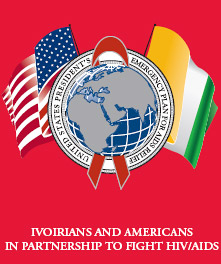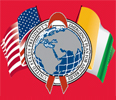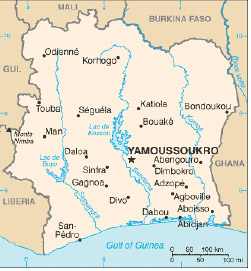| 2008 Country Profile: Côte d’Ivoire PDF version PDF version

 |
|
2008 Country Profile: Côte d’Ivoire
National HIV/AIDS prevalence among adults (ages 15-49): 3.9 percent1
Adults and children (ages 0-49) living with HIV at the end of 2007: 480,0001
AIDS deaths (adults and children) in 2007: 38,0001
AIDS orphans at the end of 2007: 420,0001
Côte d’Ivoire is one of PEPFAR’s 15 focus countries, which collectively represent approximately 50 percent of HIV infections worldwide. Under PEPFAR, Côte d’Ivoire received more than $24.3 million in Fiscal Year (FY) 2004, nearly $44.4 million in FY 2005, approximately $46.6 million in FY 2006, and $84.4 million in FY 2007 to support comprehensive HIV/AIDS prevention, treatment and care programs. PEPFAR is providing $120.5 million in FY 2008. | |
Recognizing the global HIV/AIDS pandemic as one of the greatest health challenges of our time, President George W. Bush announced the President’s Emergency Plan for AIDS Relief (PEPFAR) in 2003 — the largest international health initiative in history by one nation to address a single disease. The United States is changing the paradigm for development, rejecting the flawed “donor-recipient” mentality and replacing it with an ethic of true partnership. These partnerships are having a global impact and transforming the face of our world today.
Partnership to Fight HIV/AIDS
The Government of Côte d’Ivoire provides strong leadership despite the country’s ongoing political military turmoil. In 2001, the government created a specific ministry to coordinate the national HIV/AIDS response and mobilize national and international resources. In addition, the government has mandated each ministry to create a multi-sectoral committee to focus on sector-specific HIV/AIDS-related responses and to improve overall coordination with the Ministry of the Fight against AIDS.
The U.S. Government is the largest supporter of HIV/AIDS efforts and plays an important role in supporting Côte d’Ivoire’s comprehensive national HIV/AIDS response.
The USG role includes:
- Supporting activities to build human capacity in coordination with the government and development partners;
- Supporting and building a comprehensive continuum-of-care network model for prevention, treatment and care to provide the highest quality of services to those living with and affected by HIV;
- Ensuring that sufficient human resources are available to sustain programs and achieve national prevention, treatment and care goals; and
- Promoting long-term sustainability of quality HIV services by effectively engaging the private sector.
| PEPFAR Results in Côte d’Ivoire |
| # of individuals receiving antiretroviral treatment as of March 31, 20081 |
|
39,700 |
| # of HIV-positive individuals who received care and support in FY2007 (including TB/HIV)1 |
|
74,300 |
| # of orphans and vulnerable children (OVCs) who were served by an OVC program in FY20071 |
|
41,200 |
| # of pregnant women receiving HIV counseling and testing services for PMTCT since the beginning of PEPFAR1,2 |
|
189,100 |
| # of HIV-positive pregnant women receiving antiretroviral prophylaxis for PMTCT since the beginning of PEPFAR1,3 |
|
12,800 |
| # of counseling and testing encounters (in settings other than PMTCT) in FY20071 |
|
90,900 |
| # of individuals reached with community outreach HIV/AIDS prevention programs that promote Abstinence and/or Being Faithful in FY2007 |
|
566,300 |
| # of individuals reached with community outreach HIV/AIDS prevention activities that promote Condoms and related prevention services in FY2007 |
|
651,500 |
| # of USG condoms shipped from Calendar Year 2004 to 2007 |
|
4,848,000 |
|
Note: Numbers may be adjusted as attribution criteria and reporting systems are refined.
Numbers above 100 are rounded to nearest 100.
1 Total results combine individuals reached through downstream and upstream support.
2 It is possible that some individuals were counseled and tested more than once.
3 It is possible that some pregnant women received antiretroviral prophylaxis more than once over the four-year period, e.g. HIV positive women who were pregnant more than once. |
 |
PEPFAR Achievements in Côte d’Ivoire to Date |
|
HIV/AIDS in Côte d’Ivoire
Côte d’Ivoire has a generalized HIV epidemic with the highest prevalence rate in the West African region, estimated at 7.1 percent in adults ages 15-49. The prevalence rate appears to have remained relatively stable for the past decade, with recent declines among pregnant women in urban areas. In 2005, a national AIDS Indicator Survey was completed, which provided accurate data on various aspects of the epidemic, including prevalence rates among diverse demographic sub-groups. Populations at comparatively high risk for HIV infection include women ages 20-24, people in prostitution, youth and the military. The prolonged political-military crisis, in addition to exacerbating the vulnerability of these groups, is likely to have created additional at-risk populations given the large-scale military deployment, massive population displacement, and increase in poverty.
Challenges to PEPFAR Implementation
Political instability, delays in the disarmament process and the threat of armed insurgency continue to be major challenges and barriers to external assistance. The prolonged
| |
 |
| sociopolitical crisis has disrupted and restricted access to health and other public services, while at the same time increasing HIV transmission and vulnerability among many sub-populations. Côte d’Ivoire has a more developed public health and education system in terms of human resources and infrastructure than many of its neighbors, but the overall health system is weak, and health and economic gains have been reversed by the crisis. Currently, blood-screening services and treatment for sexually transmitted infections and tuberculosis are very limited. Regions in the North and West, which have not been under government control, have experienced a complete and prolonged disruption of public-sector services and an exodus of skilled professionals. Major disparities exist between urban and rural health services, with a paucity of health professionals and private practitioners outside the major cities.
Critical Interventions for HIV/AIDS Prevention:
- Provided technical assistance in the national development, review and dissemination of prevention of mother-to-child HIV transmission (PMTCT) policies, protocols, and guidelines, enhanced health-district ownership of PMTCT programs, and supported PMTCT services.
- Pursued a comprehensive and evidence-based prevention approach using the “ABC” (Abstain, Be faithful, correct and consistent use of Condoms) strategy to prevent sexual transmission. PEPFAR partners supported the expansion of public- and private-sector behavior change communication interventions at the community level and with targeted high-risk populations.
- Built on previous successes of targeted prevention campaigns designed for the uniformed services and ex-combatants, truckers, displaced and mobile populations, people in prostitution and their clients, sexually active in- and out-of-school youth, and health- and education-sector workers. Individual, family and couple HIV testing is used as a primary prevention tool, with linkages to HIV treatment and care.
Critical Interventions for HIV/AIDS Treatment:
- Consolidated all PEPFAR-supported procurements of antiretroviral drugs, opportunistic-infection treatments, and lab supplies under a single procurement partner, the Partnership for Supply Chain Management. Focused on developing a system that provides a continuum of comprehensive treatment and care services, including antiretroviral treatment, adherence support and monitoring, psychosocial support, palliative care, treatment of opportunistic and sexually transmitted infections, and care for HIV-affected families.
Critical Interventions for HIV/AIDS Care:
- Continued a critical role in supporting the Ministry of Health’s efforts to define a national palliative care framework and develop literacy around its concepts. A national palliative care policy was validated in August 2006 and was disseminated. Training and other implementation materials are being finalized to complement the new policy.
- Based on the 2005 national policy on orphans and vulnerable children (OVCs), standard criteria for OVC services were developed in FY2006. PEPFAR partners are working to implement, evaluate and duplicate the San Pedro district model, an innovative network of linked social and health services in the public and private sectors that reinforces local coordination bodies and links district services to regional and tertiary referral and counter-referral structures.
1 UNAIDS, Report on the Global AIDS Epidemic, 2008. |
| |  |  |




 PDF version
PDF version